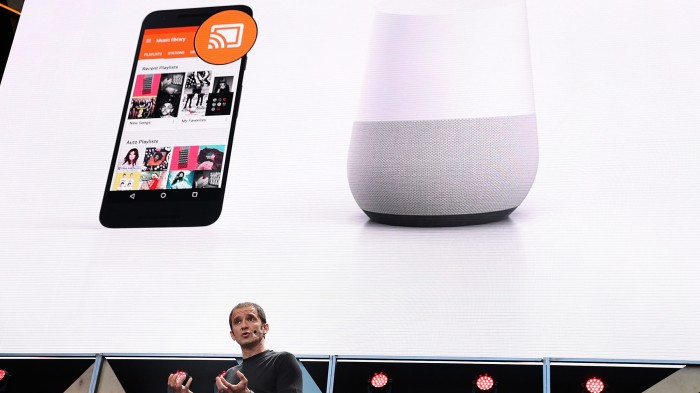In 2016, AI Home Assistants Won Our Hearts
This year, many of us let a stranger into our homes and ended up loving it. I am, of course, talking about voice-activated artificial-intelligence assistants.
The success of Amazon’s Alexa, the launch of Google’s Home, and Mark Zuckerbrg’s public quest to build his own digital butler all demonstrate that conversational interfaces, which we predicted would be a breakthrough technology in 2016, are here to stay.
Amazon’s Echo smart speaker, which is a conduit for the company’s Alexa AI assistant, was officially available to all in the U.S. from 2015. But this year it also went on sale in the U.K. and Germany, and estimates suggest that it sold as many as two million units in the first nine months of 2016. At the time of writing, the Wall Street Journal reports that the Echo is currently sold out on Amazon.com.
Meanwhile, Google launched its own competitor in the shape of Home. Powered by the search company’s Assistant AI, the small speaker received praise for its smarts, which seem to outstrip those of Amazon’s offering. As our own Tom Simonite has pointed out, neither is perfect. In November, he wrote:
Like Echo, Google Home performs well at only certain things, like controlling music. It doesn’t plug into many other devices or services yet. And just like Amazon’s product, it is limited by being tied to a single account and unable to recognize individuals, preventing customized responses that draw on a person’s other data.
But that hasn’t stopped the assistants from stealing hearts. As New Scientist recently reported, over 100,000 people say good morning to Alexa each day, and 250,000 have asked for its hand in marriage.

Why? As Backchannel points out, the thing about speech is that it allows conventional interfaces to melt away. That means we begin to interact with the AI as if it were a person rather than a device. This writer may not have declared love for his Amazon Echo Dot, the smaller sibling of the Echo, but he certainly finds it compelling enough to use every day—whether it’s asking for the radio while walking by in the morning or setting a time while cooking.
I’m not alone. Mark Zuckerberg is among the converts to the AI butler—though not one made by Amazon or Google. Yesterday, he announced that his year-long challenge to build his own smart assistant, known as Jarvis, had been a success. It controls the lights, plays music, and makes him toast. While he admits the process resulted in a complex, bespoke system that he’s not yet ready to share with the world, he does plan to continue developing it, because he now uses it every day.
The AI assistants that are available to the public are also under constant development, with updates and features being added regularly. By developing better ways to understand and interpret what you say, and encouraging third parties to build new services for the devices, the likes of Google and Amazon hope to have their digital butlers do more for you around the home. By the end of 2017, you might, for instance, be able to recite a shopping list and have the items delivered to your door without picking up a laptop or smartphone.
At least, I hope so. In the meantime, though, to Alexa and the others: Well done on a great year, and here’s to the next.
(Read more: Backchannel, New Scientist, Wall Street Journal, “Google’s New Home Helper Flexes Powerful AI Muscles,” “10 Breakthrough Technologies: Conversational Interfaces”)
Keep Reading
Most Popular
Large language models can do jaw-dropping things. But nobody knows exactly why.
And that's a problem. Figuring it out is one of the biggest scientific puzzles of our time and a crucial step towards controlling more powerful future models.
How scientists traced a mysterious covid case back to six toilets
When wastewater surveillance turns into a hunt for a single infected individual, the ethics get tricky.
The problem with plug-in hybrids? Their drivers.
Plug-in hybrids are often sold as a transition to EVs, but new data from Europe shows we’re still underestimating the emissions they produce.
Stay connected
Get the latest updates from
MIT Technology Review
Discover special offers, top stories, upcoming events, and more.